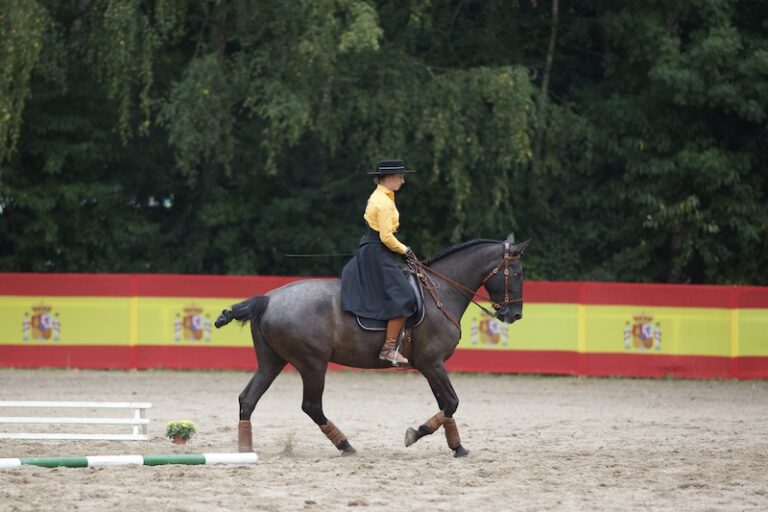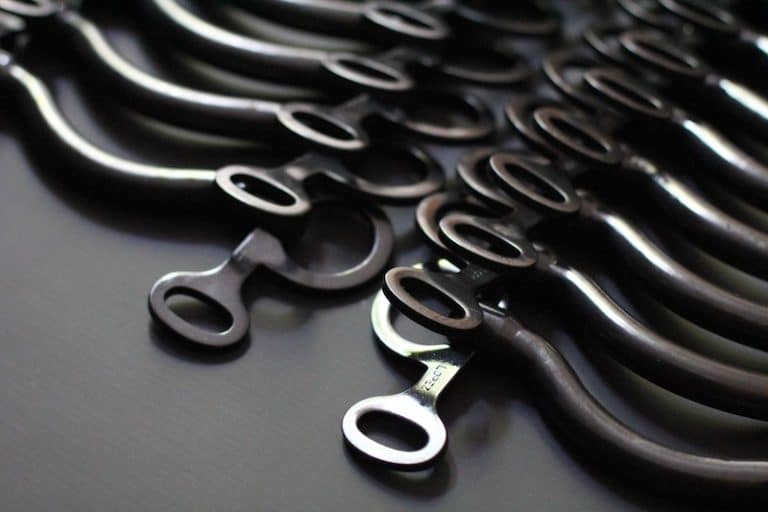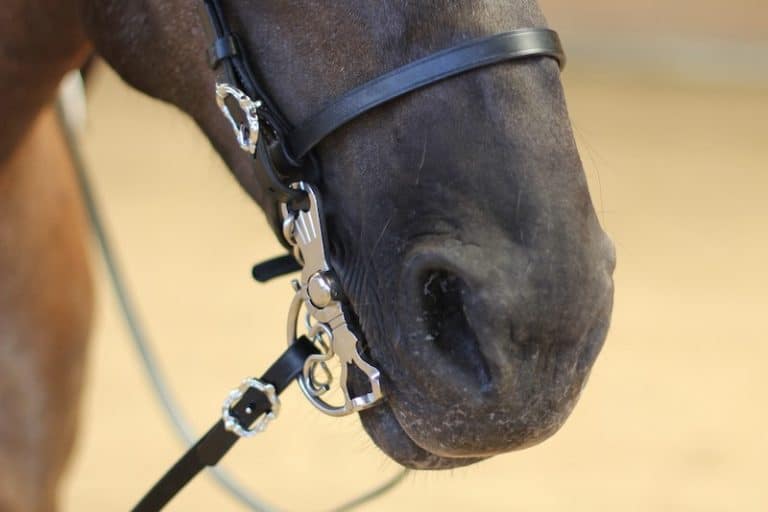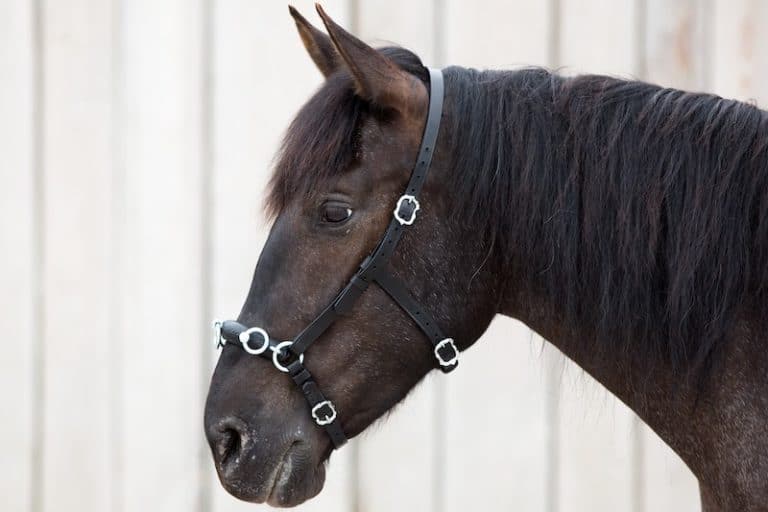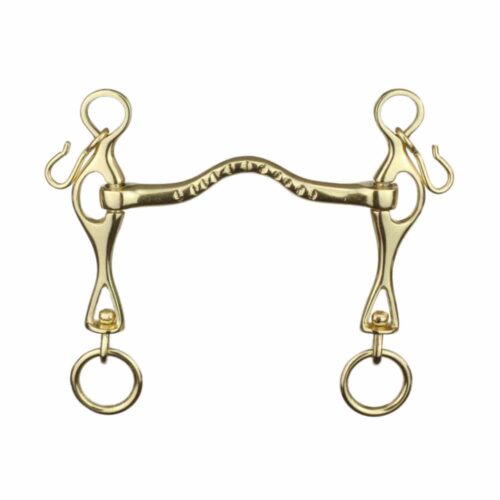Hier erfährst du mehr über den Newsletter und die Gutscheinbedingungen. Mit deiner Anmeldung stimmst du unseren Datenschutzbestimmungen zu.
Gebisse
Barocke Gebisse bei Picadera
Gebisse gibt es in den unterschiedlichen Varianten. Um das richtige Gebiss für Pferd und Reiter*in zu finden, sollte man sich zuvor einige Gedanken machen.
Gebissmaterialien
Da es Gebisse heutzutage in den unterschiedlichsten Varianten gibt, ist auch die Auswahl an Gebissmaterialien sehr umfangreich.
Edelstahlgebisse
Der Klassiker unter den Gebissmaterialien sind Edelstahlgebisse. Ihre Legierung basiert auf Eisen, Chrom und Nickel. Zwar kann Nickel Allergien auslösen, doch bei der Verschmelzung dieser Kombination entsteht ein neues Metall, welches das Nickel in sich einschließt und fest gebunden wird, sodass es nicht nach außen treten kann. Edelstahlgebisse sind rostfrei, antimagnetisch und besonders verschleißbeständig. Dadurch sind sie pflegeleicht und langlebig. Schmutz kann einfach mit Wasser abgewaschen werden.
Kupfergebisse
Kupfergebisse sind durch die 90 prozentige Sweet Copper Legierung gold gefärbt. Diese hochwertige Legierung weist eine hohe Festigkeit auf und ist durch ihre nickelfreie Formel gut für Pferd geeignet, die eine Nickelunverträglichkeit haben. Diese zeigt sich meist an gereizten Schleimhäuten. Sweet Copper Gebisse schmecken, wie der Name verraten lässt, süßlich und werden dadurch von vielen Pferden gut angenommen. Ein weiterer Vorteil ist, dass dieser Geschmack die Kautätigkeit des Pferdes animiert und so zu einer besseren Durchlässigkeit führen kann. Außerdem sind Sweet Copper Gebisse antibakteriell und nehmen Wärme sehr gut auf. Bei kalten Temperaturen kann man das Gebiss leicht mit seiner Hand erwärmen, um des dem Pferd angenehmer zu machen. Aufgrund der natürlichen Oxidationsprozesse können diese Gebisse mit der Zeit anlaufen.
Messinggebisse
Gebisse aus dieser Kupfer-Zink-Mischung weisen eine hohe Korrosionsbeständigkeit auf. Normalerweise sind die Gebisse goldfarben, doch je höher der Zinkanteil ist, desto mehr variiert die Farbe. Verchromte Messinggebissen haben eine silberne Farbe. Auch Gebisse aus diesem Material können mit der Zeit anlaufen und sollte hin und wieder poliert werden.
Eisengebisse
Eisengebisse aus Sweet Iron haben eine schwarze Farbe. Diese kommt unter anderem durch die Brünierung, bei der das Gebiss in heißem Öl gebadet wird. Eisengebisse schmecken süßlich und regen durch ihren Geschmack die Kautätigkeit des Pferdes an, was den Kiefer entspannen kann und sich somit auf den gesamten Bewegungsapparat positiv auswirken kann. Allerdings sind diese Gebisse pflegeintensiver. Natürliche Oxidationsprozesse sorgen dafür, dass sich Edel-Rost bildet. Dies ist kein Qualitätsmangel und kann das Abkauen des Pferdes noch mehr beeinflussen. Picadera rät dazu, das Gebiss gelegentlich mit einem in Olivenöl getränkten Tuch abzureiben.
Materialkombinationen – Win-Win-Situation
Natürlich gibt es auch Gebisse, bei denen zum Beispiel das Mundstück aus einem anderen Material als die Seitenteile bestehen. Hier spürt man dann die Vorteile der unterschiedlichen Materialien. Beispielsweise kann man dann ein Mundstück aus Edelstahl verwendet, während die Seitenteile aus Eisen bestehen. So hat man die dunkle Optik des Eisengebisses, doch das Edelstahl-Mundstück rostet nicht, wenn man dieses bevorzugt.
Das richtige Material?
Die Entscheidung, welches Material verwendet werden soll, muss individuell ausgemacht werden. Manche Pferde nehmen Edelstahlgebisse nur schwer an, weshalb man dann eher auf Sweet Iron oder Sweet Copper ausweichen sollte. Natürlich spielen aber auch die Vorlieben der Reiterin*des Reiters eine Rolle bei der Auswahl. Alle Gebissmaterialien haben Vor- und Nachteile.
Die Wirkung von Gebissarten
Bevor man ein Gebiss kauft, sollte man sich Gedanken darüber machen, wofür es verwendet werden soll und wie es überhaupt wirkt.
Wassertrensen
Die wohl bekannteste Gebissart ist die Wassertrense. Sie gibt es einfach gebrochen oder doppelt gebrochen mit flexiblen oder unflexiblen Ringen.
Wassertrensen mit flexiblen Ringen sind sehr beweglich im Pferdemaul. Das Pferd kann die Positionierung des Mundstückes an den Ringen selbst beeinflussen. Dies kann bei Jungpferden nützlich sein, die sich erst an das Gebiss gewöhnen müssen. Bei mauligen Pferden wird allerdings empfohlen, eher eine D-Ring Trense, Olivenkopftrense oder Schenkeltrense zu verwenden, da diese stabiler im Pferdemaul liegen.
Ein einfach gebrochenes Gebiss bildet bei Zügelanzug eine Art Haus. Das Mundstück wirkt auf die äußeren Kieferladen, die Zungeränder und kann auf den Gaumen drücken. Die Zungenmitte wird hierbei entlastet.
Doppelt gebrochene Mundstücke haben eine flachere Zungenfreiheit und üben einen gleichmäßigeren Druck aus. Hierdurch hat das doppelt gebrochene Gebiss eine etwas mildere Wirkung.
Stangengebisse
Oft wird davon geredet, dass diese Gebissart im Vergleich zum gebrochenen Gebiss noch sanfter sein soll. Allerdings muss man beachten, dass die Stange frontal auf die gesamte Kieferlade wirkt. Die Zunge wird hierbei nicht entlastet. Beim Reiten mit Stangengebissen ist auch eine ruhige Reiterhand wichtig, da bei unausgeglichenem Zügelzug die Stange im Maul “kippt”.
Stangengebisse gibt es mit und ohne Zungenfreiheit. Mundstücke mit kleiner Zungenfreiheit haben einen kleinen Bogen in der Mitte. Für Pferde mit fleischiger Zunge gibt es Mullen Mouth Modelle, die einen großen geschwungenen Bogen haben, um diese zu entlasten.
Gebisse ohne Hebelwirkung
Baucher Gebisse, Schenkeltrensen und Wassertrensen besitzen keine Hebelwirkung. Sie wirken nur über die Zunge, die Lade oder die Maulwinkel, wie bei dem Baucher Gebiss. Auch die beliebte Kimblewick Trense kann ohne Hebelwirkung geritten werden, wenn die Zügel in der oberen Aussparung eingeschnallt werden.
Das Baucher Gebiss besitzt nur einen kurzen Oberbaum, der an den Backenstücken befestigt wird. Hierdurch hat das Gebiss eine besonders ruhige Lage im Pferdemaul und ist so gut für sensible Pferde oder Jungpferde geeignet. Die Zügel werden in den Ringen befestigt. Das Baucher Gebiss wird ohne Kinnriemen oder Kinnkette geritten. Es besitzt keinen Unterbaum, der mit einer Kinnkette als Gegenspieler agieren könnte, um Druck auf das Genick auszuüben. Im Gegenteil: das Baucher Gebiss liegt durch seinen besonderen Aufbau sehr stabil, sodass auch gebrochene Mundstücke nicht nach unten durchhängen und an die Schneidezähne kommen könnten.
Gebisse mit Hebelwirkung
Kandaren, Pelhams und Kimblewick Trensen sind Gebisse, die eine Hebelwirkung entfalten. Bei Zügelanzug wird Druck auf die Zunge, die Lade und das Genick erzeugt. Diese Gebisse gehören nur in erfahrene Reiter*innenhände. Sie werden in Kombination mit Kinnketten geritten, die entdreht ihn die Kinnkettenhaken eingehängt werden. Kimblewick Trensen können zur Umgewöhnung von der Wassertrense oder dem Baucher Gebiss zu einer Kandare verwendet werden, da sie eine mildere Hebelwirkung besitzen. Wird der Zügel in die untere Aussparung des Gebisses eingefädelt, wirkt das Kimblewick Gebiss wie eine milde Kandare. Bei diesem Gebiss kann man die Zügel allerdings auch einfach in den großen Ring einhängen. Nimmt das Pferd den Kopf dann zu hoch, rutscht der Zügel nach unten und die Hebelwirkung setzt ein. Hält das Pferd den Kopf zu tief, gleitet der Zügel nach oben und das Gebiss wirkt wie eine Wassertrense. Kandaren, Pelham und Kimblewick können auch vierzügelig geritten werden. Die spanische Kandare wird traditionelle ohne Unterlegtrense, also blank, geritten.
Manche Baucher Gebisse und auch Pumpkandaren besitzen ein vertikales Spiel. Das Mundstück kann sich etwas an den Seitenteilen auf und ab bewegen. Dieses leichte Spiel regt die Kautätigkeit des Pferdes an. Der Kiefer kann sich durch das Abkauen entspannen und das Pferd läuft insgesamt zufriedener, wenn es losgelassen ist.
Die korrekte Passform
Damit ein Gebiss überhaupt richtig wirken kann, muss es die richtige Größe haben und korrekt verschnallt sein.
Die Backenstücke sollten so verschnallt sein, dass sich am Pferdemaul eine kleine Falte bildet. Dann sitzt das Gebiss auf der richtigen Höhe.
Die Gebissweite
Die Gebissweite kommt auf die Gebissart an.
Wassertrensen mit beweglichen Ringen sollten 0,5cm größer gekauft werden. Hier besteht nämlich die Gefahr, dass die Lefzen zwischen Mundstück und Gebissring eingeklemmt werden können. Dies gilt auch für Unterlegtrensen, die mit einer Kandare kombiniert werden. Kandaren, Baucher Gebisse, Olivenkopftrensen, Schenkeltrensen und weitere Gebisse, die keine flexiblen Ringe besitzen, sollten dicht an den Maulwinkeln anliegen, um über die Seitenteile richtig wirken zu können.
Die Gebissdicke
Da Pferdeköpfe heutzutage immer filigraner gezüchtet werden, verkürzt sich auch die Maulspalte und somit der Platz im Maul. Bei diesen Pferden können gerne dünnere Gebisse verwendet werden. Viele Pferde finden aber auch dickere Gebisse angenehmer. Hier kommt es wieder auf das Pferd an und wie es auf das Mundstück reagiert. Dünne Gebisse sind nicht unbedingt schärfer als dicke Gebisse. Falls man sich trotz dessen unsicher ist, ob man lieber ein dünnes oder dickes Gebiss verwenden soll, kann man auch den seine Pferde-Zahnärztin oder seinen Pferde-Zahnarzt zu Rate ziehen.
-
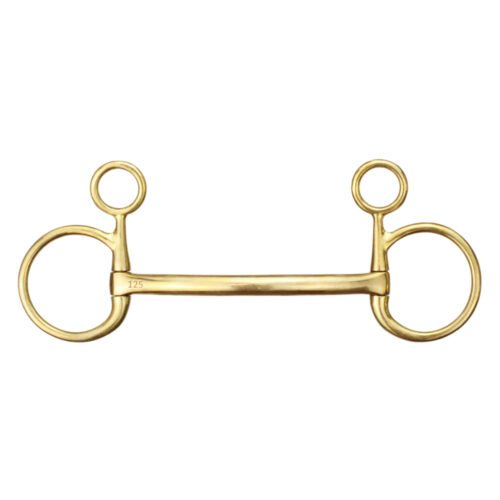
Baucher Gebiss PICADERA Mullen Mouth Messing Gold
99 € inkl. MwSt.
Enthält 19% MwSt.zzgl. Versand -
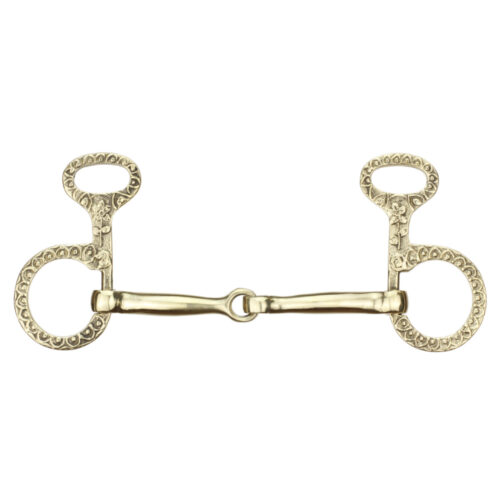
Baucher Gebiss BAROCK Einfach Gebrochen 12 mm Messing Gold
89 € inkl. MwSt.
Enthält 19% MwSt.zzgl. Versand -
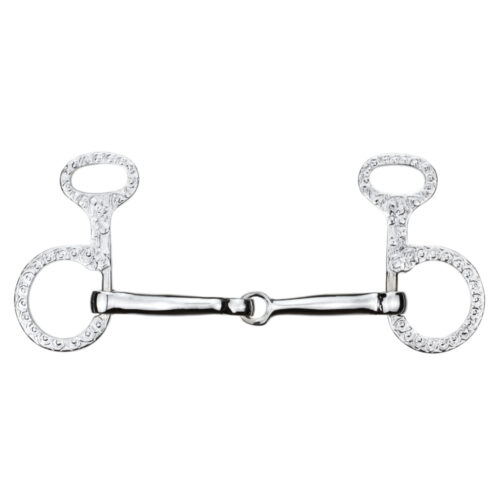
Baucher Gebiss BAROCK Einfach Gebrochen 12 mm Messing Silber
89 € inkl. MwSt.
Enthält 19% MwSt.zzgl. Versand -
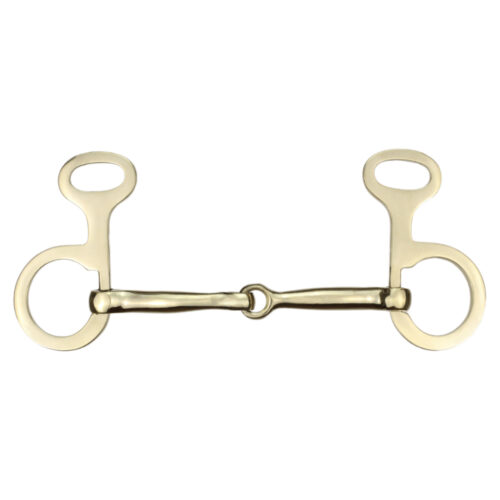
Baucher Gebiss MESSING Einfach Gebrochen 12 mm Gold
79 € inkl. MwSt.
Enthält 19% MwSt.zzgl. Versand -
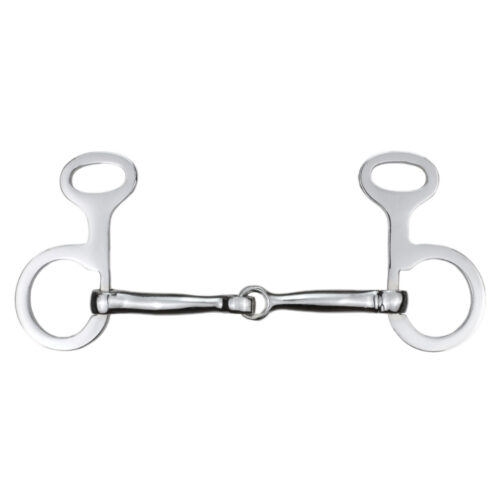
Baucher Gebiss MESSING Einfach Gebrochen 12 mm Silber
79 € inkl. MwSt.
Enthält 19% MwSt.zzgl. Versand -
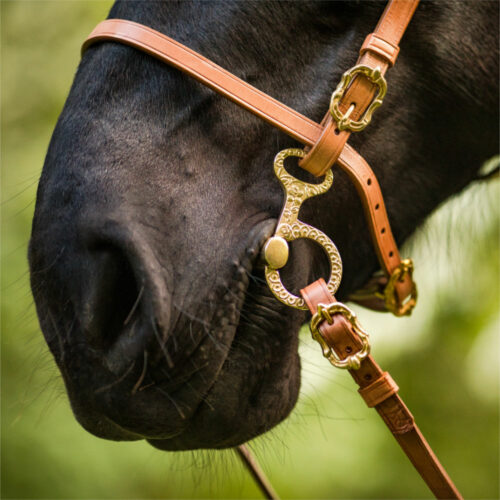
Baucher Gebiss BAROCK Kleine Zungenfreiheit Messing Gold
79 € inkl. MwSt.
Enthält 19% MwSt.zzgl. Versand -
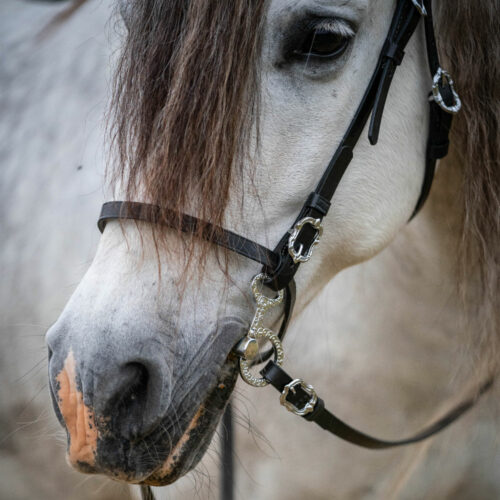
Baucher Gebiss BAROCK Kleine Zungenfreiheit Messing Silber
79 € inkl. MwSt.
Enthält 19% MwSt.zzgl. Versand -
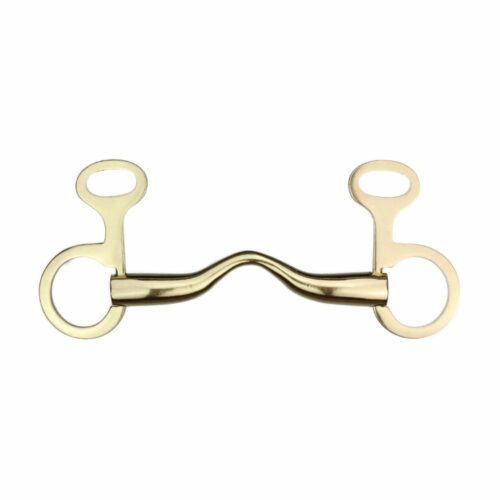
Baucher Gebiss MESSING Kleine Zungenfreiheit Gold
69 € inkl. MwSt.
Enthält 19% MwSt.zzgl. Versand -
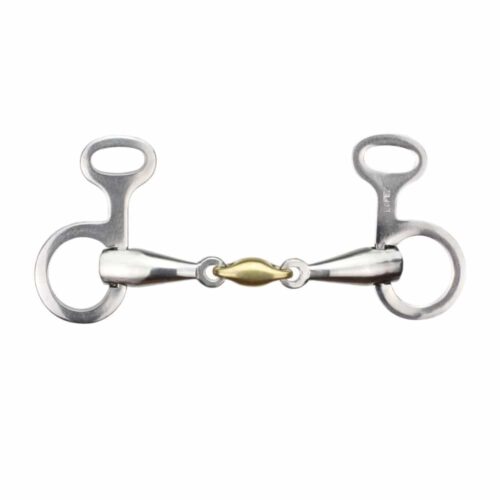
Baucher Gebiss VAQUERO Doppelt Gebrochen Edelstahl
69 € inkl. MwSt.
Enthält 19% MwSt.zzgl. Versand -
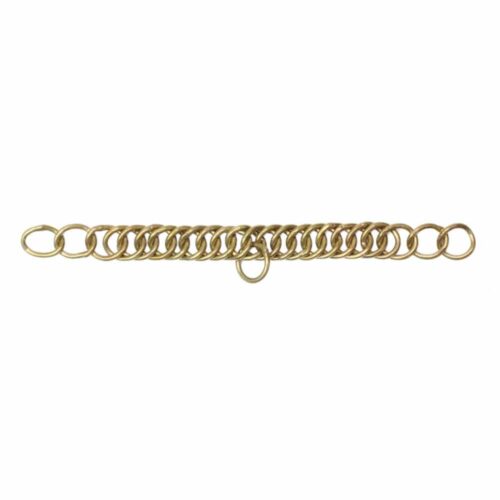
Kinnkette BALAO Messing Gold
11,99 € inkl. MwSt.
Enthält 19% MwSt.zzgl. Versand -
-27%
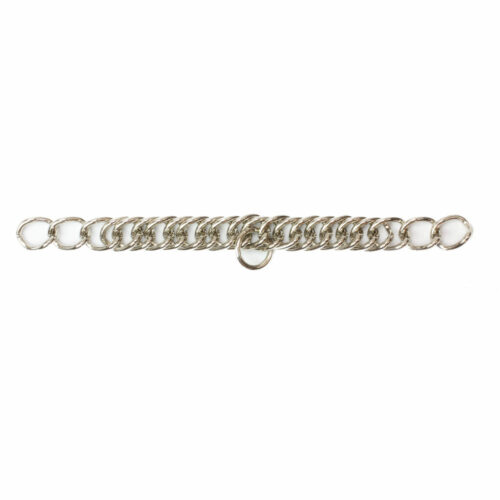
Kinnkette BALAO Messing Silber
7,99 € inkl. MwSt.
Enthält 19% MwSt.zzgl. Versand
Barocke Gebisse bei Picadera
Gebisse gibt es in den unterschiedlichen Varianten. Um das richtige Gebiss für Pferd und Reiter*in zu finden, sollte man sich zuvor einige Gedanken machen.
Gebissmaterialien
Da es Gebisse heutzutage in den unterschiedlichsten Varianten gibt, ist auch die Auswahl an Gebissmaterialien sehr umfangreich.
Edelstahlgebisse
Der Klassiker unter den Gebissmaterialien sind Edelstahlgebisse. Ihre Legierung basiert auf Eisen, Chrom und Nickel. Zwar kann Nickel Allergien auslösen, doch bei der Verschmelzung dieser Kombination entsteht ein neues Metall, welches das Nickel in sich einschließt und fest gebunden wird, sodass es nicht nach außen treten kann. Edelstahlgebisse sind rostfrei, antimagnetisch und besonders verschleißbeständig. Dadurch sind sie pflegeleicht und langlebig. Schmutz kann einfach mit Wasser abgewaschen werden.
Kupfergebisse
Kupfergebisse sind durch die 90 prozentige Sweet Copper Legierung gold gefärbt. Diese hochwertige Legierung weist eine hohe Festigkeit auf und ist durch ihre nickelfreie Formel gut für Pferd geeignet, die eine Nickelunverträglichkeit haben. Diese zeigt sich meist an gereizten Schleimhäuten. Sweet Copper Gebisse schmecken, wie der Name verraten lässt, süßlich und werden dadurch von vielen Pferden gut angenommen. Ein weiterer Vorteil ist, dass dieser Geschmack die Kautätigkeit des Pferdes animiert und so zu einer besseren Durchlässigkeit führen kann. Außerdem sind Sweet Copper Gebisse antibakteriell und nehmen Wärme sehr gut auf. Bei kalten Temperaturen kann man das Gebiss leicht mit seiner Hand erwärmen, um des dem Pferd angenehmer zu machen. Aufgrund der natürlichen Oxidationsprozesse können diese Gebisse mit der Zeit anlaufen.
Messinggebisse
Gebisse aus dieser Kupfer-Zink-Mischung weisen eine hohe Korrosionsbeständigkeit auf. Normalerweise sind die Gebisse goldfarben, doch je höher der Zinkanteil ist, desto mehr variiert die Farbe. Verchromte Messinggebissen haben eine silberne Farbe. Auch Gebisse aus diesem Material können mit der Zeit anlaufen und sollte hin und wieder poliert werden.
Eisengebisse
Eisengebisse aus Sweet Iron haben eine schwarze Farbe. Diese kommt unter anderem durch die Brünierung, bei der das Gebiss in heißem Öl gebadet wird. Eisengebisse schmecken süßlich und regen durch ihren Geschmack die Kautätigkeit des Pferdes an, was den Kiefer entspannen kann und sich somit auf den gesamten Bewegungsapparat positiv auswirken kann. Allerdings sind diese Gebisse pflegeintensiver. Natürliche Oxidationsprozesse sorgen dafür, dass sich Edel-Rost bildet. Dies ist kein Qualitätsmangel und kann das Abkauen des Pferdes noch mehr beeinflussen. Picadera rät dazu, das Gebiss gelegentlich mit einem in Olivenöl getränkten Tuch abzureiben.
Materialkombinationen – Win-Win-Situation
Natürlich gibt es auch Gebisse, bei denen zum Beispiel das Mundstück aus einem anderen Material als die Seitenteile bestehen. Hier spürt man dann die Vorteile der unterschiedlichen Materialien. Beispielsweise kann man dann ein Mundstück aus Edelstahl verwendet, während die Seitenteile aus Eisen bestehen. So hat man die dunkle Optik des Eisengebisses, doch das Edelstahl-Mundstück rostet nicht, wenn man dieses bevorzugt.
Das richtige Material?
Die Entscheidung, welches Material verwendet werden soll, muss individuell ausgemacht werden. Manche Pferde nehmen Edelstahlgebisse nur schwer an, weshalb man dann eher auf Sweet Iron oder Sweet Copper ausweichen sollte. Natürlich spielen aber auch die Vorlieben der Reiterin*des Reiters eine Rolle bei der Auswahl. Alle Gebissmaterialien haben Vor- und Nachteile.
Die Wirkung von Gebissarten
Bevor man ein Gebiss kauft, sollte man sich Gedanken darüber machen, wofür es verwendet werden soll und wie es überhaupt wirkt.
Wassertrensen
Die wohl bekannteste Gebissart ist die Wassertrense. Sie gibt es einfach gebrochen oder doppelt gebrochen mit flexiblen oder unflexiblen Ringen.
Wassertrensen mit flexiblen Ringen sind sehr beweglich im Pferdemaul. Das Pferd kann die Positionierung des Mundstückes an den Ringen selbst beeinflussen. Dies kann bei Jungpferden nützlich sein, die sich erst an das Gebiss gewöhnen müssen. Bei mauligen Pferden wird allerdings empfohlen, eher eine D-Ring Trense, Olivenkopftrense oder Schenkeltrense zu verwenden, da diese stabiler im Pferdemaul liegen.
Ein einfach gebrochenes Gebiss bildet bei Zügelanzug eine Art Haus. Das Mundstück wirkt auf die äußeren Kieferladen, die Zungeränder und kann auf den Gaumen drücken. Die Zungenmitte wird hierbei entlastet.
Doppelt gebrochene Mundstücke haben eine flachere Zungenfreiheit und üben einen gleichmäßigeren Druck aus. Hierdurch hat das doppelt gebrochene Gebiss eine etwas mildere Wirkung.
Stangengebisse
Oft wird davon geredet, dass diese Gebissart im Vergleich zum gebrochenen Gebiss noch sanfter sein soll. Allerdings muss man beachten, dass die Stange frontal auf die gesamte Kieferlade wirkt. Die Zunge wird hierbei nicht entlastet. Beim Reiten mit Stangengebissen ist auch eine ruhige Reiterhand wichtig, da bei unausgeglichenem Zügelzug die Stange im Maul “kippt”.
Stangengebisse gibt es mit und ohne Zungenfreiheit. Mundstücke mit kleiner Zungenfreiheit haben einen kleinen Bogen in der Mitte. Für Pferde mit fleischiger Zunge gibt es Mullen Mouth Modelle, die einen großen geschwungenen Bogen haben, um diese zu entlasten.
Gebisse ohne Hebelwirkung
Baucher Gebisse, Schenkeltrensen und Wassertrensen besitzen keine Hebelwirkung. Sie wirken nur über die Zunge, die Lade oder die Maulwinkel, wie bei dem Baucher Gebiss. Auch die beliebte Kimblewick Trense kann ohne Hebelwirkung geritten werden, wenn die Zügel in der oberen Aussparung eingeschnallt werden.
Das Baucher Gebiss besitzt nur einen kurzen Oberbaum, der an den Backenstücken befestigt wird. Hierdurch hat das Gebiss eine besonders ruhige Lage im Pferdemaul und ist so gut für sensible Pferde oder Jungpferde geeignet. Die Zügel werden in den Ringen befestigt. Das Baucher Gebiss wird ohne Kinnriemen oder Kinnkette geritten. Es besitzt keinen Unterbaum, der mit einer Kinnkette als Gegenspieler agieren könnte, um Druck auf das Genick auszuüben. Im Gegenteil: das Baucher Gebiss liegt durch seinen besonderen Aufbau sehr stabil, sodass auch gebrochene Mundstücke nicht nach unten durchhängen und an die Schneidezähne kommen könnten.
Gebisse mit Hebelwirkung
Kandaren, Pelhams und Kimblewick Trensen sind Gebisse, die eine Hebelwirkung entfalten. Bei Zügelanzug wird Druck auf die Zunge, die Lade und das Genick erzeugt. Diese Gebisse gehören nur in erfahrene Reiter*innenhände. Sie werden in Kombination mit Kinnketten geritten, die entdreht ihn die Kinnkettenhaken eingehängt werden. Kimblewick Trensen können zur Umgewöhnung von der Wassertrense oder dem Baucher Gebiss zu einer Kandare verwendet werden, da sie eine mildere Hebelwirkung besitzen. Wird der Zügel in die untere Aussparung des Gebisses eingefädelt, wirkt das Kimblewick Gebiss wie eine milde Kandare. Bei diesem Gebiss kann man die Zügel allerdings auch einfach in den großen Ring einhängen. Nimmt das Pferd den Kopf dann zu hoch, rutscht der Zügel nach unten und die Hebelwirkung setzt ein. Hält das Pferd den Kopf zu tief, gleitet der Zügel nach oben und das Gebiss wirkt wie eine Wassertrense. Kandaren, Pelham und Kimblewick können auch vierzügelig geritten werden. Die spanische Kandare wird traditionelle ohne Unterlegtrense, also blank, geritten.
Manche Baucher Gebisse und auch Pumpkandaren besitzen ein vertikales Spiel. Das Mundstück kann sich etwas an den Seitenteilen auf und ab bewegen. Dieses leichte Spiel regt die Kautätigkeit des Pferdes an. Der Kiefer kann sich durch das Abkauen entspannen und das Pferd läuft insgesamt zufriedener, wenn es losgelassen ist.
Die korrekte Passform
Damit ein Gebiss überhaupt richtig wirken kann, muss es die richtige Größe haben und korrekt verschnallt sein.
Die Backenstücke sollten so verschnallt sein, dass sich am Pferdemaul eine kleine Falte bildet. Dann sitzt das Gebiss auf der richtigen Höhe.
Die Gebissweite
Die Gebissweite kommt auf die Gebissart an.
Wassertrensen mit beweglichen Ringen sollten 0,5cm größer gekauft werden. Hier besteht nämlich die Gefahr, dass die Lefzen zwischen Mundstück und Gebissring eingeklemmt werden können. Dies gilt auch für Unterlegtrensen, die mit einer Kandare kombiniert werden. Kandaren, Baucher Gebisse, Olivenkopftrensen, Schenkeltrensen und weitere Gebisse, die keine flexiblen Ringe besitzen, sollten dicht an den Maulwinkeln anliegen, um über die Seitenteile richtig wirken zu können.
Die Gebissdicke
Da Pferdeköpfe heutzutage immer filigraner gezüchtet werden, verkürzt sich auch die Maulspalte und somit der Platz im Maul. Bei diesen Pferden können gerne dünnere Gebisse verwendet werden. Viele Pferde finden aber auch dickere Gebisse angenehmer. Hier kommt es wieder auf das Pferd an und wie es auf das Mundstück reagiert. Dünne Gebisse sind nicht unbedingt schärfer als dicke Gebisse. Falls man sich trotz dessen unsicher ist, ob man lieber ein dünnes oder dickes Gebiss verwenden soll, kann man auch den seine Pferde-Zahnärztin oder seinen Pferde-Zahnarzt zu Rate ziehen.
Tipps aus der Picadera Community
